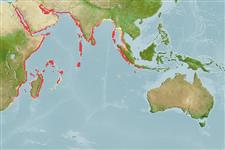Common names from other countries
>
Acanthuriformes (Surgeonfishes) >
Acanthuridae (Surgeonfishes, tangs, unicornfishes) > Nasinae
Etymology: Naso: Latin, nasus = nose (Ref. 45335); elegans: From the Latin for choice, fine, or nice (Ref. 37792).
More on author: Rüppell.
Environment: milieu / climate zone / depth range / distribution range
Ökologie
seewasser riff-verbunden; tiefenbereich 5 - 30 m (Ref. 90102). Tropical; 30°N - 35°S, 30°E - 118°E (Ref. 37792)
Indian Ocean: Red Sea south to Durban, South Africa and east through the islands of the western Indian Ocean to southwestern Indonesia, at least to Bali.
Size / Gewicht / Alter
Maturity: Lm ? range ? - ? cm
Max length : 45.0 cm SL Männchen/unbestimmt; (Ref. 37792); common length : 35.0 cm TL Männchen/unbestimmt; (Ref. 30573)
Rückenflossenstacheln (insgesamt): 6; Rückenflossenweichstrahlen (insgesamt): 26-30; Afterflossenstacheln 2; Afterflossenweichstrahlen: 27 - 30. Dorsal fin yellow with a blue line at base and a black band above this; anal and pelvic fins dark brown; dorsal and anal fins with a narrow blue margin and black submarginal line; caudal fin yellowish with black upper and lower margins and a submarginal black band posteriorly (Ref. 37792). Caudal fin emarginate with adult males having trailing filaments from each corner (Ref. 37792).
Inhabits coastal and sheltered reef flats in small groups and schools in oceanic locations (Ref. 48637). Also found in rocky bottoms in about 5-30 m (Ref. 90102). Feeds on benthic algae (Ref. 37792).
Life cycle and mating behavior
Geschlechtsreife | Fortpflanzung | Ablaichen | Eier | Fecundity | Larven
Randall, J.E., 2001. Surgeonfishes of Hawai'i and the world.. Mutual Publishing and Bishop Museum Press, Hawai'i. 123 p. (Ref. 37792)
IUCN Rote Liste Status (Ref. 130435)
CITES (Ref. 128078)
Not Evaluated
Bedrohung für Menschen
Harmless
Nutzung durch Menschen
Fischereien: kommerziell
Mehr Information
NamenSynonymeMetabolismusRäuberÖkotoxikologieFortpflanzungGeschlechtsreifeAblaichenFecundityEierEientwicklung
ReferenzenAquakulturAquakultur ProfilZuchtlinienGenetikElectrophoresesVererbbarkeitKrankheitenVerarbeitungMass conversion
Tools
Zusatzinformationen
Download XML
Internet Quellen
Estimates based on models
Preferred temperature (Ref.
115969): 24.8 - 28.7, mean 27.1 (based on 172 cells).
Phylogenetic diversity index (Ref.
82804): PD
50 = 0.5000 [Uniqueness, from 0.5 = low to 2.0 = high].
Bayesian length-weight: a=0.02291 (0.00950 - 0.05523), b=2.97 (2.76 - 3.18), in cm Total Length, based on LWR estimates for this (Sub)family-body shape (Ref.
93245).
Trophic level (Ref.
69278): 2.0 ±0.00 se; based on food items.
Widerstandsfähigkeit (Ref.
120179): mittel, Verdopplung der Population dauert 1,4 - 4,4 Jahre. (Preliminary K or Fecundity.).
Fishing Vulnerability (Ref.
59153): Moderate vulnerability (42 of 100).
